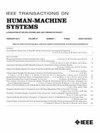Human Comfort Index Estimation in Industrial Human–Robot Collaboration Task
IF 4.4
3区 计算机科学
Q2 COMPUTER SCIENCE, ARTIFICIAL INTELLIGENCE
引用次数: 0
Abstract
Effective human–robot collaboration (HRC) requires robots to understand and adapt to humans' psychological states. This research presents a novel approach to quantitatively measure human comfort levels during HRC through the development of two metrics: a comfortability index (CI) and an uncomfortability index (UnCI). We conducted HRC experiments where participants performed assembly tasks while the robot's behavior was systematically varied. Participants' subjective responses (including工业人机协作任务中人体舒适度的估计
有效的人机协作(HRC)要求机器人理解并适应人类的心理状态。本研究提出了一种新的方法,通过发展两个指标:舒适指数(CI)和不舒适指数(UnCI)来定量测量HRC期间人类的舒适度。我们进行了HRC实验,参与者执行组装任务,而机器人的行为是系统地变化的。参与者的主观反应(包括惊讶、焦虑、无聊、冷静和舒适度评分)与生理信号(包括心电图、皮肤电反应和瞳孔测量数据)一起被收集。我们提出了两种估算CI/UnCI的新方法:一种是将舒适度映射到唤醒价空间的情感循环模型的适应,另一种是基于生理数据训练的核密度估计模型。从生理信号中提取时域特征,并用于训练机器学习模型,用于实时舒适度估计。我们的研究结果表明,所提出的方法可以有效地从生理信号中估计人类的舒适水平,其中环plex模型在检测高不适状态方面表现出特别的希望。这项工作能够在HRC期间实时测量人体舒适度,为开发更具适应性和人类意识的协作机器人提供基础。
本文章由计算机程序翻译,如有差异,请以英文原文为准。
求助全文
约1分钟内获得全文
求助全文
来源期刊

IEEE Transactions on Human-Machine Systems
COMPUTER SCIENCE, ARTIFICIAL INTELLIGENCE-COMPUTER SCIENCE, CYBERNETICS
CiteScore
7.10
自引率
11.10%
发文量
136
期刊介绍:
The scope of the IEEE Transactions on Human-Machine Systems includes the fields of human machine systems. It covers human systems and human organizational interactions including cognitive ergonomics, system test and evaluation, and human information processing concerns in systems and organizations.
 求助内容:
求助内容: 应助结果提醒方式:
应助结果提醒方式:


